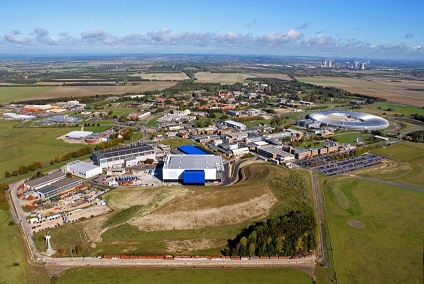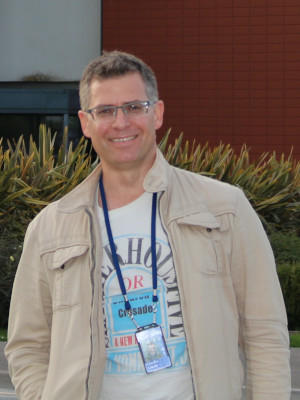Sustainable modelling software for large scale physics experiments
Posted on 2 December 2019
Sustainable modelling software for large scale physics experiments
 Photo credit: Science and Technology Facilities Council
Photo credit: Science and Technology Facilities CouncilBy Software Sustainability Institute Fellow Leandro Liborio
Large scale experiments are a necessity of modern science. The Rutherford Appleton Laboratory (RAL) is one of the largest European research organisations operating the sort of large scale research facilities that are needed for those kinds of experiments. Facilities such as synchrotron light sources, particle accelerators, neutron and muon sources and powerful scientific computers are available at RAL, and research carried out at these facilities have contributed to advancements in areas as diverse as health, the environment, energy research, culture, and history.
RAL is located on the Harwell Science and Innovation Campus at Chilton, in Oxfordshire. It has a staff of over 1,200 people whose main function is to support the work of over 10,000 scientists and engineers from all over the world, who come to work in the lab from private companies, other national laboratories and the university research community.
This blog post is about my Institute fellowship project, which involves two branches of these scientific facilities: muon science and scientific computing. My project specifically focuses on promoting the development of sustainable modelling software for supporting muon experiments. Computational modelling can be used to interpret muon experiments as well as to provide unique insights into the nature of the physical processes associated with the experimental results.
Muon spectroscopy is a powerful experimental technique in physics. It involves using the muon, a subatomic particle almost ten times lighter than a proton, as a microscopic probe that we implant into a material and that can be used to probe the local environment around the muon. Contrary to other experimental techniques, where a beam of particles hits a material sample and is diffracted by it, the muon beam ‘stops’ inside the material sample. There are currently four muon sources around the world: one at RAL, one in Switzerland, one in Canada and another one in Japan. In all these places, the muon technique is used in areas including chemistry, materials science, physics and, more recently, archaeology. Therefore, with such a broad range of users, the modelling software that is produced must be not only sustainable but also user friendly.
The muon community is mainly composed of experimental scientists, but there is also a number of people who perform computational modelling, who have made significant advances in the use of modelling techniques for muon experiments. However, given that there are few incentives for developing sustainable software, the modelling community has prioritised scientific results over software sustainability. This feature is one of main drivers behind my fellowship proposal, which focuses on developing sustainable software for muon experiments and on building a community of practice in this area.
Hence, as part of my fellowship, I am visiting the different muon sources to learn about the experimental and modelling efforts in these places, and to discuss with my colleagues the modelling requirements for the muon techniques that are specific to their muon source. Between 11 and 13 November 2019, I visited the Laboratory for Muon Spin Spectroscopy (LMU) at the Paul Scherrer Institute (PSI), near Zürich, in Switzerland, where there is the Swiss muon source. LMU has a unique muon instrument called the Low-Energy Muon beam, where muons can be implanted at controllable depths within a sample and be used to study thin films and multi-layered structured materials.
During the visit, I gave a seminar at PSI where I described the simulation methods and associated software tools that we are developing at RAL and which form part of the Muon Spectroscopy Computational Project. This was followed by a set of discussions with many of the scientists working at LMU, where I had the chance to familiarise myself with some of the details of their experimental techniques and, in particular, with some of their modelling work and software needs. Among these needs is the ability to predict, from purely computational methods, the muon’s implantation site, which is a problem common to all muon experiments and for which we - at RAL- have developed a set of tools that have been tested on many systems and are in the process of becoming sustainable software tools for the muon community. I demonstrated how some of these tools worked and we are now collaborating on a combined theoretical-experimental study on Yttrium Oxy-hydrides, which are materials that have photochromic properties: their colour changes when they are illuminated with certain types of light. We have all, at some point, seen a photochromic material: the most famous application of these type of materials are colour-changing lenses for glasses.
In the second day of the visit, I met with members of PSI’s Scientific Computing Department, some of whom are developers of a well-known modelling software called cp2k, which could be adapted to be used with the software tools that we developed at RAL. I had a very enriching discussion with these people and I think there is mutual interest in learning from each other and in advancing muon science. I am already thinking about specific cases where we could join efforts to develop software for the muon community.
Overall, I think this was a very productive and enriching visit, and I believe that it is a step in the right direction for building a community of practice in computational muon science. Now my experimental colleagues from PSI have a better appreciation of what our simulations can do for their experiments. Similarly, I think that my colleagues from the Scientific Computing Department at PSI now know that we are developing a new and rich area of research in the computational modelling of muon experiments, and that we could joint efforts to develop better software for better muon research.

